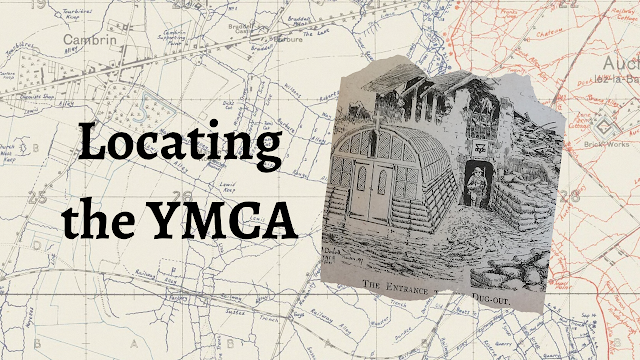Finding 'The Dairy': Locating the YMCA's Huts in the Ypres Salient
At the height of the Third Battle of Ypres in late 1917, there were more than 80 YMCA huts located in the Ypres Salient, meaning that there was on average one establishment every three kilometres. The Association worked hard to ensure that a soldier was never too far from a YMCA rest hut while on active service, so that they could access comforts and refreshments as often as possible.
A number of these were located within the ruins of Ypres city, making use of the cellars and ramparts as protected locations. Yet dozens of others spread out eastwards towards the front lines, supporting soldiers in the reserve trenches and the rest camps. Mentions of these huts crop up repeatedly throughout soldiers' letters and diaries but often only giving a vague sense of their location. Arthur Linfoot, for example, described having 'called at the YM' near Locre for 'tea and a tune' before he 'walked in to Mont Rouge'. Moreover, in news reporting of the YMCA's facilities locations are rarely given as part of the censorship of British army positions.
Finding where these huts were located has long been a curiosity of mine. I enjoy visiting the battlefields and treading the fields and lanes once inhabited by soldiers. For a while on these trips I have been wondering exactly where the huts were. To locate trench lines I use the Linesman Great War Digital software, but unfortunately there aren't many buildings marked on these trench maps, and there's especially no reference to the YMCA.
Without maps or stated locations, finding the huts becomes a whole lot trickier. I usually start with a photo or sketch of one and try to locate it from there, matching it with clues in the descriptions of soldiers and Association workers.

One such hut I managed to track down was at La Laiterie, just north of Kemmel towards the south of the Ypres Salient. Photos from 1917 on both the Imperial War Museum and the Australian War Memorial websites show this YMCA as being in the basement of a ruined house, with a further sandbagged structure being located out front.
Coincidentally, I came across a very similar sketch in the YMCA's journal. Drawn by W Cecil Dunford, the Association's artist in Ypres, it's a front on view of the sandbagged chapel and the entrance into the cellar. The accompanying article gave me the clues to be able to locate 'La Laiterie'.
 |
| Sketched version of 1918 map |
Looking back at the IWM photos, I noticed a sign on the side of the house cautioning about the 'Overland Route' along the side of the house. Matching this with Dunford's description of the cemetery as being opposite the entry way gave the most likely location of the hut as being on the opposite side of the road from La Laiterie Cemetery.
Last year I then visited the site, which is now just a tarmac parking place for the nearby farm. Unremarkable, for sure, yet it felt amazing to have been able to place a YMCA site, and even moreso to be able to visualise how it fitted in to the landscape of the battlefield. It was built mere metres from the trenches, at the base of the Messines Ridge. It would have been convenient for soldiers on their way out of the line, but also in a convenient position of being on the Kemmel-Vierstraat road and so close to the field dressing station.
Although in a shelled out building, Dunford described how there was a 'cheerful fire and the effect of the glow of the light upon the faces in contrast with the gloomy cellar mad ea subject which would send an artist into ecstacies.' It was through this gloom that 'could be dimly seen the ever-present counter, and the still more important tea-urn'. This dark and, no doubt, damp cellar was a comfort to soldiers, providing them with a warming cup of tea, a place to write home, and somewhere to decompress with chums, maybe playing a game.
A small haven from the reminders of death literally right outside the door.
Kathryn






Hi This is very interesting. I am trying to research the Scottish Churches' Huts in the same area. Especially at the end of 1917 when my grandfather was there.
ReplyDeleteKia ora Kathryn, fantastic detective work! Must have been extremely satisfying to pull this all together and finally locate the La Laiterie YMCA site. Best wishes, Glenn
ReplyDeletegh
ReplyDeleteThen you don't need to stress over support so a lot, and an enduring shed that will fill its need.
ReplyDeletecarport
This is very interesting Kathryn – thanks for posting it.
ReplyDeleteIn your research did you come across mention of an Australian YMCA padre/Lieutenant at Ypres. H.C. Fusedale was his name "Charlie". According to historian Julian Foynes he and his wife (Sadie - though apparently she was using the name Bernine) left Ypres late March 1819 – I don't know when they arrived there.
Ramparts
ReplyDelete